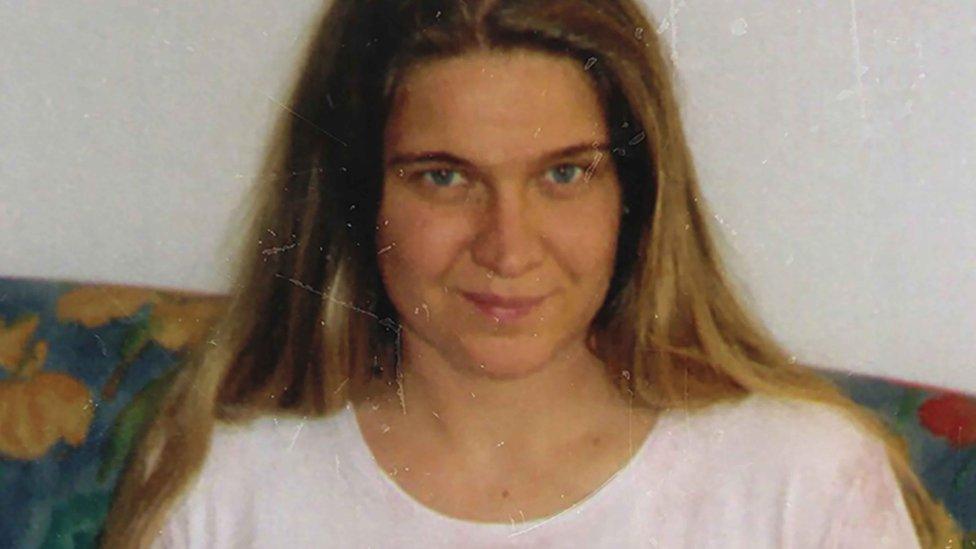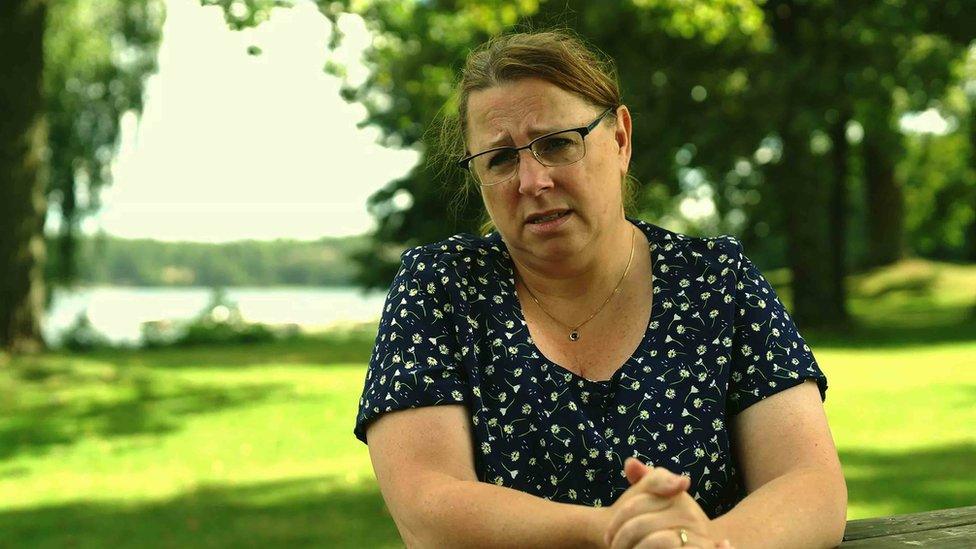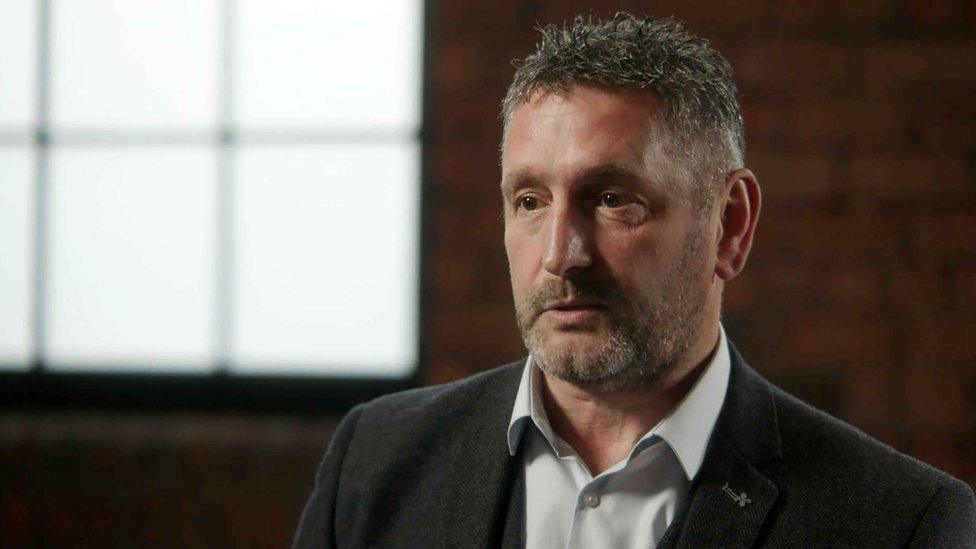How did Annie’s body end up on a Scottish beach?
- Published

Annie Börjesson arrived in Edinburgh from Sweden in 2004 - but was found dead the next year
After Annie Börjesson's body was found on a beach in Scotland in 2005, police maintained her death was a suicide or an accident. For years Annie's family and friends have called for further investigation and now a BBC documentary series looks into the case.
When Annie arrived in Edinburgh in 2004, from Sweden, she enrolled in English classes and later began working at a tourist hotspot.
The 30-year-old could already speak six languages, she was a talented singer and her friends describe her as chatty and lively.
"Annie was a beautiful young woman and was like a sister to me," one of her closest friends, Maria Jansson, remembers. "She was independent, she was strong with her long, thick blonde hair. She was like a Viking princess."
In December 2005, Annie told her friends and family back home in Sweden she was planning to return home for a visit over Christmas.
She left her flat in Edinburgh on the afternoon of Saturday 3 December with a packed travel bag and her passport. She'd also paid advance rent on her flat, had booked a hair appointment in Sweden and was carrying library books to be returned to her home country.
Later that day, CCTV at Prestwick Airport picked up footage of Annie entering the terminal at 15:14. In the footage, she walks into the airport for about five minutes then exits the same way she came.
It's unclear why she left the airport, but the next confirmed sighting of Annie would be when her body was found face down on Prestwick beach, just over a mile away, the next day.

CCTV picked up footage of Annie entering Prestwick Airport the day before she was found
She was discovered by a dog walker - and her belongings were scattered around her.
Police at the time deemed the most likely cause of death to be suicide or an accident, but her loved ones always had questions.
Now a BBC documentary has spent a year looking again at Annie's case, saying there are questions to answer over the original investigation by authorities and that new material has emerged in the years since.
And the team behind the film, Rogan Productions, has written a submission to the Scottish Fatalities Investigation Unit (SFIU) - which investigates sudden, suspicious, accidental and unexplained deaths - arguing that it should re-examine what happened to Annie.

Body on the Beach: What Happened to Annie?
Her death was reported as suicide, but her family believes otherwise. How did Annie Börjesson die? Journalist Hazel Martin looks into the case.
Available on BBC iPlayer from Tuesday 4 July.

Although police say there is no evidence that criminality was involved in Annie's death, Maria has long called for a re-examination of the case.
She says 18 years is "an inhumanly long time" for Annie's loved ones to wait for answers, adding: "We would never have put ourselves through this nightmare if we all did not strongly believe that Annie was murdered."
'You don't forget'
Among the 11 points included in the SFIU submission letter is the discrepancy around Annie's post-mortem and markings on her body.
The original official Scottish post-mortem carried out three days after her body was found said there was no evidence of trauma to Annie's body.
But Swedish undertaker Gun Daneberg, who received Annie's body once it was back in her home country and handled the funeral, told the documentary that in her career spanning four decades she had "never experienced anything like this before, you don't forget". Not formally asked to examine the body, she adds: "When we opened the coffin, I still remember seeing finger marks around her neck. Two marks, I remember them so clearly."

Annie's friend Maria says 18 years is "an inhumanly long time" for Annie's loved ones to wait for answers
The submission letter also points to the refusal of police and Scotland's Crown Office, the country's public prosecution service and death investigation authority, to release information that relates to Annie's case to her family, including photographs taken by the police of the body at the time of the post-mortem.
Police have argued there was not strong enough public interest in the photos and that they would be distressing for the family to see.
The letter goes on to discuss laboratory evidence that Annie had types of micro-organism in her system which suggest she may have drowned in freshwater instead of saltwater, which is what you would have expected at Prestwick beach.
'Doesn't add up'
Although Annie told people close to her she was anxious in the days leading up to her death, friends who saw her reject the idea that she took her own life.
When she visited her friend and colleague Kat Dalmo two days before her body was found, Kat says she "was in a good mood, she didn't seem depressed at all, it doesn't add up".
Confirming the findings of the police investigation, Michael Neill, a detective who was on duty the morning Annie's body was found, says: "There was never anything at all to indicate that there was any criminality involved in Annie's death."

Michael Neill, who was on duty as a detective on the morning Annie's body was found, says no evidence of criminality was found in her death
But Dr Stuart Hamilton, a forensic pathologist for 15 years who was consulted for the BBC documentary, says it would be helpful for the family to have the case re-examined.
The circumstances around Annie's drowning are not clear, in his view, and further investigation into the case could be "valuable".
"I think, if nothing else, to ease the minds of the people who loved her," Dr Hamilton says.
Confirming receipt of the submission, the Crown Office and Procurator Fiscal Service, which looks after the SFIU, said that although they consider the original conclusion of Annie's death to be supported by all available evidence, they are always open to new evidence and will keep her family informed of any developments.
And Det Supt Paul Livingstone, from Police Scotland's specialist crime division, said: "We understand how distressing this must be for family and friends," adding that Annie's death was fully investigated and there was no evidence of criminality.
Sources of support are available via the BBC Action Line.
Additional reporting by Shola Lee and Harvey Day.
BBC images courtesy: Rogan Scotland